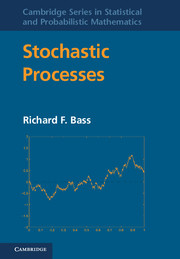Book contents
- Frontmatter
- Contents
- Preface
- Frequently used notation
- 1 Basic notions
- 2 Brownian motion
- 3 Martingales
- 4 Markov properties of Brownian motion
- 5 The Poisson process
- 6 Construction of Brownian motion
- 7 Path properties of Brownian motion
- 8 The continuity of paths
- 9 Continuous semimartingales
- 10 Stochastic integrals
- 11 Itô's formula
- 12 Some applications of Itô's formula
- 13 The Girsanov theorem
- 14 Local times
- 15 Skorokhod embedding
- 16 The general theory of processes
- 17 Processes with jumps
- 18 Poisson point processes
- 19 Framework for Markov processes
- 20 Markov properties
- 21 Applications of the Markov properties
- 22 Transformations of Markov processes
- 23 Optimal stopping
- 24 Stochastic differential equations
- 25 Weak solutions of SDEs
- 26 The Ray–Knight theorems
- 27 Brownian excursions
- 28 Financial mathematics
- 29 Filtering
- 30 Convergence of probability measures
- 31 Skorokhod representation
- 32 The space C[0, 1]
- 33 Gaussian processes
- 34 The space D[0, 1]
- 35 Applications of weak convergence
- 36 Semigroups
- 37 Infinitesimal generators
- 38 Dirichlet forms
- 39 Markov processes and SDEs
- 40 Solving partial differential equations
- 41 One-dimensional diffusions
- 42 Lévy processes
- Appendices
- References
- Index
1 - Basic notions
Published online by Cambridge University Press: 05 June 2012
- Frontmatter
- Contents
- Preface
- Frequently used notation
- 1 Basic notions
- 2 Brownian motion
- 3 Martingales
- 4 Markov properties of Brownian motion
- 5 The Poisson process
- 6 Construction of Brownian motion
- 7 Path properties of Brownian motion
- 8 The continuity of paths
- 9 Continuous semimartingales
- 10 Stochastic integrals
- 11 Itô's formula
- 12 Some applications of Itô's formula
- 13 The Girsanov theorem
- 14 Local times
- 15 Skorokhod embedding
- 16 The general theory of processes
- 17 Processes with jumps
- 18 Poisson point processes
- 19 Framework for Markov processes
- 20 Markov properties
- 21 Applications of the Markov properties
- 22 Transformations of Markov processes
- 23 Optimal stopping
- 24 Stochastic differential equations
- 25 Weak solutions of SDEs
- 26 The Ray–Knight theorems
- 27 Brownian excursions
- 28 Financial mathematics
- 29 Filtering
- 30 Convergence of probability measures
- 31 Skorokhod representation
- 32 The space C[0, 1]
- 33 Gaussian processes
- 34 The space D[0, 1]
- 35 Applications of weak convergence
- 36 Semigroups
- 37 Infinitesimal generators
- 38 Dirichlet forms
- 39 Markov processes and SDEs
- 40 Solving partial differential equations
- 41 One-dimensional diffusions
- 42 Lévy processes
- Appendices
- References
- Index
Summary
In a first course on probability one typically works with a sequence of random variables X1, X2, … For stochastic processes, instead of indexing the random variables by the positive integers, we index them by t ∈ [0, ∞) and we think of Xt as being the value at time t. The random variable could be the location of a particle on the real line, the strength of a signal, the price of a stock, and many other possibilities as well.
We will also work with increasing families of σ-fields {ℱt}, known as filtrations. The σ-field ℱt is supposed to represent what we know up to time t.
Processes and σ-fields
Let (Ω, ℱ, ℙ) be a probability space. A real-valued stochastic process (or simply a process) is a map X from [0,∞) × Ω to the reals. We write Xt = Xt(ω) = X (t, ω). We will impose stronger measurability conditions shortly, but for now we require that the random variables Xt be measurable with respect to ℱ for each t ≥ 0.
A collection of σ-fields ℱt such that ℱt ⊂ ℱ for each t and ℱs ⊂ ℱt if s ≤ t is called a filtration. Define ℱt+ = ∩∈ > 0ℱt+∈. A filtration is right continuous if ℱt+ = ℱt for all t ≥ 0. The σ-field ℱt+ is supposed to represent what one knows if one looks ahead an infinitesimal amount. Most of the filtrations we will come across will be right continuous, but see Exercise 1.1.
A null set N is one that has outer probability 0.
- Type
- Chapter
- Information
- Stochastic Processes , pp. 1 - 5Publisher: Cambridge University PressPrint publication year: 2011
- 1
- Cited by



